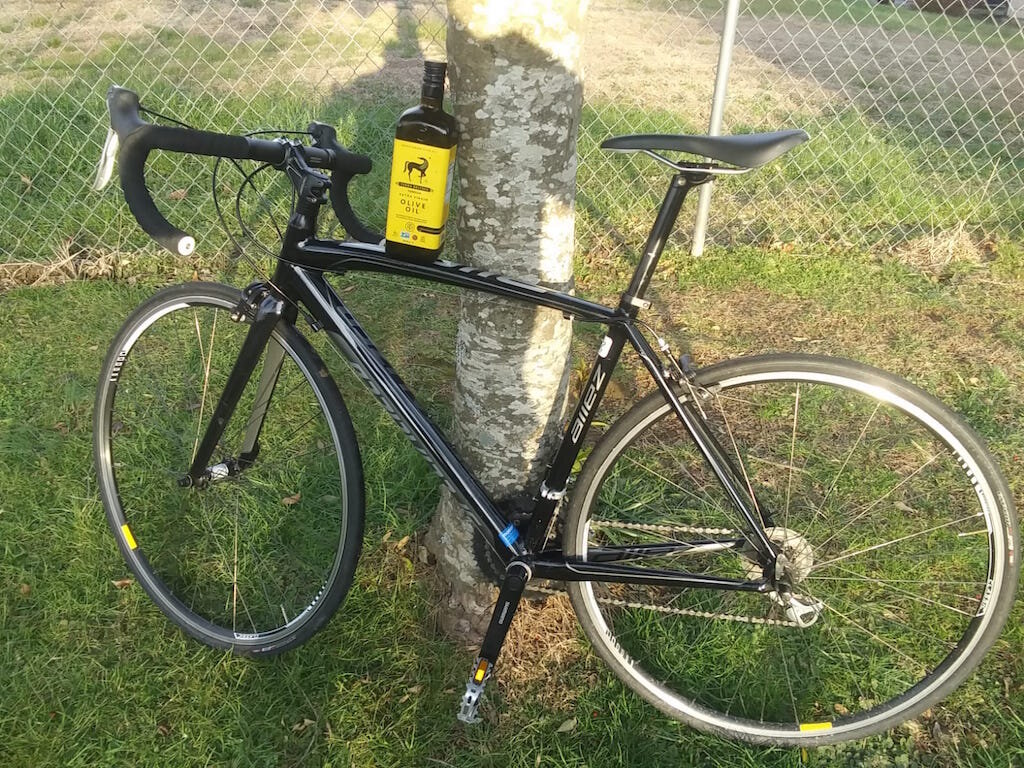Are there substitutes for bicycle chain lubes?
Technically, you can use any lubricant for your bicycle chain, however, some lubes work significantly better than others.
Also, keep in mind that most lubricants are designed to be used in a closed system, not for use in a bicycle drivetrain that’s exposed to all the environmental elements and dirt & debris.
This article analyzes many common lubes you have in your home and lets you know if they are suitable for application on your bike chain. First, we start with what makes an ideal bike-specific lubricant.
What is an ideal bicycle lubricant?
A bicycle lube provides a lubricant film that separates metal-to-metal contact between the cogs and the chain. The main method for reducing drivetrain friction is by creating a single layer of lubricant molecules which impedes the direct contact of surfaces.
An ideal bicycle lubricant will be thick enough to prevent any metal-to-metal contact but still thin enough to penetrate the inner components of the chain. If the chain lube is too thick (high viscosity), the performance decreases as the drag force is increased, which not only makes you slower but also increases the rate that your chain will stretch or wear.
Ingredients in a bike-specific chain lubricant:
All lubricants are composed of two components:
A base oil (mineral, synthetic, or biological)
Plus additives
Lubes are 80-98% base oil and 2-20% additives
Ideal additives for bicycle chains:
Anti-wear - These additives, such as Lubrizol LZ4370LG, significantly reduces wear in your drivetrain system. These function by creating a protective layer that reduces the amount of contact and thus reduces wear.
Friction Modifiers - These are additives that modify how the frictional behavior of the system works by forming a chemical layer on the top layer that has a very low shear strength. Molybdenum dialkyldithiocarbamate is a very common example used for bicycle-specific chain lubes.
Oxidation Stability (anti-oxidants) - Oxidation is increased from exposure to water and heat. These are especially important for biological or eco-friendly lubricants (veggie oil base lube).
Grease is the same as lube except that grease has thickeners added to it, which is why it’s described as “a sponge that holds the lubricant.”
Chain lube alternatives
Vegetable Oils
Olive oil. For you salad or your chain???
Vegetable oils, such as canola, sesame seed, corn, peanut, cottonseed, linseed, rapeseed, and olive oil, all reduce the amount of friction to very similar levels to those of bike-specific lubricants.
Castor oil is a very poor performance bike-lubricant because it is so thick, it’s not able to penetrate the rollers.
While most vegetable oils will reduce the amount of force needed to pedal a bicycle to similar levels of those of bike specific lubricants (in laboratory settings), the main reason you wouldn’t want to use them is because they will pick up LOTS of DIRT and GRIME.
Also, keep in mind that veggie oils have low oxidative stability compared to synthetic or petroleum-based oils, which means the oils will degrade and lose their lubricating and protection properties fairly quickly.
Exposure to water makes veggie oils oxidize or breakdown even faster and turn into a sludge (not good for base oils in wet bike-lubes).
Vegetable oils offer poor protection against corrosion
Can I use veggie oils as a chain lube?
No. These oils will attract dirt and the oil itself will degrade and oxidize quickly. These types of oils should be avoided unless used in an emergency.
Chainsaw (bar) Oil
Chainsaw oil is designed to be sticky. This oil needs to stick to a chain that is spinning at between 10,000 to 14,000 RPM. Compare this to a bicycle chain that is spinning at 60 - 100 RPM. You can see quite easily how much stickier chainsaw oil needs to be than what is optimal for your bike chain.
Main functions of chainsaw (bar) oil:
Stick to the blade
Reduce operating temperatures as the blades get very hot
Protect against rust
99% of chainsaw oil is either absorbed into the sawdust, sticks to the logs, gets trapped in the loggers’ clothes, or ends up on the ground.
Bar (chainsaw) oil is designed to be super sticky since nearly all of it flings off the blade. This super sticky component means it won’t come off your bike chain but means that any dirt or debris will instantly stick to it too.
Can I use chainsaw oil on my bike chain?
Yes. You can use chainsaw (bar) oil as a wet bike chain lube and would be best used for riding in inclement weather where you need a sticky oil that will not get washed off from rain or wet conditions. Unless you’re consistently riding in rainy weather, this lube is too sticky for most riding conditions.
motor oils
Motor oils have a much greater percentage of additives compared to bike-specific lubes. Also, the additives of motor oil are much different than those for chain oils, as motor oil has extreme pressure (EP) additives, deactivators, and tackiness agents, none of which make your bicycle chain perform any better.
Engine oils are more susceptible to oxidation than any other lubricant (keep in mind these oils are designed for a closed system)
Can I use motor oil as a chain lube?
You can use motor oil. However, it’s not recommended as this oil is too thick and won’t penetrate the inner components.
If you want to make a ‘thin’ version of this it would be better, but motor oil is not an ideal chain lubricant as the additives don’t protect against wear nor does it provide optimal reduction of friction. Also, it oxidizes when applied in open-air applications as it’s designed to be used in a closed system.
Gear oil
Gear oil is a thick lubricant made specifically for transmissions, transfer cases, and automobile differentials. Most gear oils have extreme pressure (EP) additives, which are useless for bicycle lubes, as cyclists rarely even generate 1-horse-power. The high viscosity attracts dirt and debris making this less than an ideal lube.
High viscosity = very thick. Gear oil is too thick to penetrate the rollers and internal workings of your chain.
Extreme Pressure (EP) additives are a vital component of gear oil. The additive profile of these gear oils does nothing for cycling.
Viscosity Improver - These oils are designed to be used in machines that run at high temperatures. As the temperature changes, it alters the viscosity of the lubricant, so additives are important when used in machinery. Also, the lubricant is responsible for removing heat from the system. None of these functions are needed for bicycle lubes and these modify the frictional force and wear properties of lube, neither of which is good for optimal bicycle chain performance.
Can I use gear oil on my bike chain?
Use at your own risk of sub-optimal performance and a very dirty chain as trail and road debris will cling to this sticky oil designed specifically for specialized high-temperature gearboxes.
Machine Oil
Light machine oil, such as sewing machine oil, is nearly 100% pure-base oil or white mineral oil.
Sewing machine oil (Image Source: Wikimedia Commons)
Can I use machine oil on my chain?
Since machine oils are nearly 100% white mineral oil, these lack performance, and anti-wear additives. If you don’t care about performance this will work, but I’d reserve this oil for the sewing machine.
wd-40
WD40 should NOT be used on your chain since WD40 is NOT a lubricant. WD40 is a solvent. This means you can use it to clean your chain, however, after application, you will need to apply an actual lubricant.
READ: I have an entire article about WD-40, you can read if you would like more info.
3-IN-1 Multi-Purpose Oil
3-IN-1 oil uses a naphthenic base oil, which is known for its high freezing point, little oxidation, ideal viscosity for chain use, and great viscosity variation with temperature fluctuations.
Naphthenic based oils are relatively aggressive for seals, which is why they are not used in closed systems. However, they are great for bicycle chains, which is why several bike-specific lube manufacturers use them as a base oil.
READ: I’ve also written a more in-depth article about 3-IN-ONE Oil for bicycle chains if you would like a more in-depth reading.
Can I use 3-IN-ONE oil on my chain?
Yes. 3-IN-ONE oil was originally designed for bicycle chains and outperforms many bike-specific lubricants available in the market place.
Final Thought
You can use any oils or lubricants that are not very thick and penetrates every link of your chain. However, a superior bike lubricant will provide you with over 30 watts of power compared to many of the lubes mentioned. So how much faster is 30 watts of power….about 1 mph (1.6kph).
All the alternative lubricants mentioned on this list are wet lubes. Depending on the trail or road that your riding, the lubes ability to propel dirt is probably the most important characteristic. Weather permitting, a quality dry lubricant is best for the prevention of grime accumulation.
Bicycle lube scientifically formulated to go faster! Learn More NOW
Jesse is the Director of Pedal Chile and lives in Valdivia, Chile. Jesse has a Master of Science in Health & Human Performance and a Bachelor of Science in Kinesiology. Hobbies: Mountain biking, bicycle commuting, snowboarding, reading, weight-lifting, taster of craft beers, & researching.
More articles from Pedal Chile





















